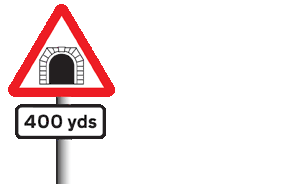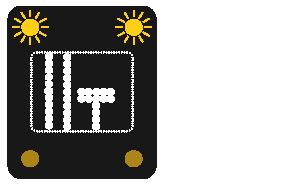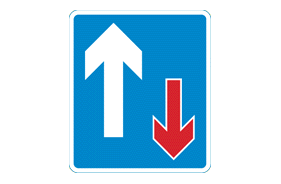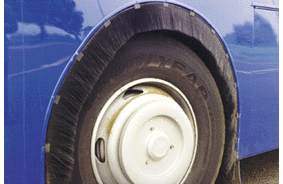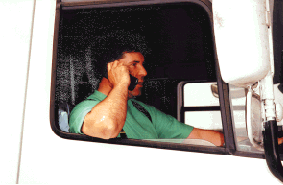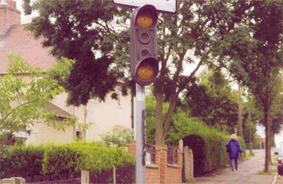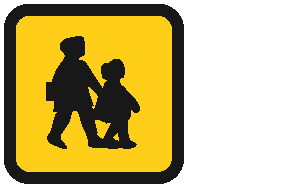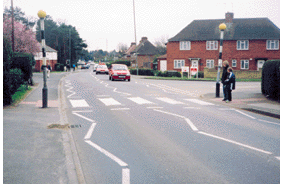You have 115 minutes (1 hour 55 minutes) to answer 100 multiple choice PCV theory test questions. You must score at least 85 out of 100 to pass the test. Answers may be checked after each question or you can wait until the end of the test to view your results. Good luck!
PCV Theory Test Practice (2024)
Test Quick View
Click question box to reveal the correct answer. You can print these questions out by clicking the printer icon.
Correct Answer: B
Explanation: As well as a height restriction, the tunnel may have a restriction on the available width of headroom for high vehicles. The advance warning gives you the opportunity to find another route if your vehicle is too high or wide to drive through the tunnel.
Explanation: As well as a height restriction, the tunnel may have a restriction on the available width of headroom for high vehicles. The advance warning gives you the opportunity to find another route if your vehicle is too high or wide to drive through the tunnel.
Correct Answer: C
Explanation: Hitting a bridge with your vehicle can have serious consequences for road and rail traffic. You must tell the police about the incident immediately. If the bridge is a railway bridge, call the railway authority as well as the police to report the incident.
Explanation: Hitting a bridge with your vehicle can have serious consequences for road and rail traffic. You must tell the police about the incident immediately. If the bridge is a railway bridge, call the railway authority as well as the police to report the incident.
Correct Answer: A
Explanation: If your vehicle touches bells suspended over the road, they'll obviously ring. This will warn you that your vehicle exceeds the safe travelling height beneath electrified overhead cables ahead. You must stop immediately and either find another route or take advice.
Explanation: If your vehicle touches bells suspended over the road, they'll obviously ring. This will warn you that your vehicle exceeds the safe travelling height beneath electrified overhead cables ahead. You must stop immediately and either find another route or take advice.
Correct Answer: B
Explanation: Warning lights show when there's danger ahead. This includes
Explanation: Warning lights show when there's danger ahead. This includes
- lane closures
- incidents
- fog
- icy roads.
Correct Answer: C
Explanation: Look out for variable-message warning signs telling you about
Explanation: Look out for variable-message warning signs telling you about
- lane closures
- speed limits
- hazards.
Correct Answer: C
Explanation: You're allowed to extend your daily driving time twice a week, to 10 hours a day. A 'day' is generally any 24-hour period that starts when you begin driving (or other work) again, after the last daily or weekly rest period.
Explanation: You're allowed to extend your daily driving time twice a week, to 10 hours a day. A 'day' is generally any 24-hour period that starts when you begin driving (or other work) again, after the last daily or weekly rest period.
Correct Answer: A
Explanation: The tachograph is a tool designed to help you be a safe and responsible driver. The tachograph records details of your journey, including time driven, speed and rest periods.
Explanation: The tachograph is a tool designed to help you be a safe and responsible driver. The tachograph records details of your journey, including time driven, speed and rest periods.
Correct Answer: A
Explanation: If there's nothing embedded in the wound, you can control the blood loss by applying pressure to the wound and raising the leg if possible.
Explanation: If there's nothing embedded in the wound, you can control the blood loss by applying pressure to the wound and raising the leg if possible.
9. At the scene of an incident, an injured person is lying in a busy road. What's the first thing you should do to help?
Mark one answer
B
C
D
Correct Answer: D
Explanation: You should warn other road users that there has been a incident. You can do this by displaying an advance warning triangle or by switching on hazard warning lights or other lights. However you choose to warn people of the incident, make sure it doesn't put you or others at risk.
Explanation: You should warn other road users that there has been a incident. You can do this by displaying an advance warning triangle or by switching on hazard warning lights or other lights. However you choose to warn people of the incident, make sure it doesn't put you or others at risk.
Correct Answer: C
Explanation: Faulty power steering will make your steering wheel very difficult or almost impossible to turn. Continuing to drive could cause danger to you and other road users. You should park safely and get help.
Explanation: Faulty power steering will make your steering wheel very difficult or almost impossible to turn. Continuing to drive could cause danger to you and other road users. You should park safely and get help.
11. You discover that one of your rear brake-light bulbs has failed. How soon should it be replaced?
Mark one answer
B
C
D
Correct Answer: B
Explanation: Bulbs should be replaced as soon as you're aware that they've failed. Carry a stock of all the various bulbs used on your vehicle, so you can repair a fault without delay.
Explanation: Bulbs should be replaced as soon as you're aware that they've failed. Carry a stock of all the various bulbs used on your vehicle, so you can repair a fault without delay.
Correct Answer: D
Explanation: It's an offence to leave a vehicle unattended on a public road with the engine running. Take care if you have to open the cab door directly into the road. Look for passing traffic - especially cyclists or motorcyclists - that may not be visible in your mirrors.
Explanation: It's an offence to leave a vehicle unattended on a public road with the engine running. Take care if you have to open the cab door directly into the road. Look for passing traffic - especially cyclists or motorcyclists - that may not be visible in your mirrors.
Correct Answer: C
Explanation: The only time you may use hazard warning lights while driving is when you're on an unrestricted dual carriageway or motorway and you want to warn other drivers of a hazard or obstruction ahead. Only use them for long enough to make sure your warning is seen.
Explanation: The only time you may use hazard warning lights while driving is when you're on an unrestricted dual carriageway or motorway and you want to warn other drivers of a hazard or obstruction ahead. Only use them for long enough to make sure your warning is seen.
Correct Answer: D
Explanation: To make sure it's safe, you must use the mirrors well before you make any manoeuvre. For example, you need to use them before moving off, turning, overtaking, slowing or stopping, opening a door, or changing direction, lanes or speed.
Explanation: To make sure it's safe, you must use the mirrors well before you make any manoeuvre. For example, you need to use them before moving off, turning, overtaking, slowing or stopping, opening a door, or changing direction, lanes or speed.
Correct Answer: A
Explanation: As you pass pedestrians or vehicles on your left, you should use your nearside mirror and check that you've passed them safely. You need to allow a good safety margin before you move back to the left.
Explanation: As you pass pedestrians or vehicles on your left, you should use your nearside mirror and check that you've passed them safely. You need to allow a good safety margin before you move back to the left.
Correct Answer: A
Explanation: You must make sure that you adjust the seat so that you're able to reach all the controls and see in all the mirrors before you start to drive any vehicle. You should also be able to lean out of the window and check your offside blind spots.
Explanation: You must make sure that you adjust the seat so that you're able to reach all the controls and see in all the mirrors before you start to drive any vehicle. You should also be able to lean out of the window and check your offside blind spots.
Correct Answer: B
Explanation: When driving large vehicles, windscreen pillars and large mirrors can easily create blind spots as you look left and right at junctions. Altering your body position slightly while looking into the new road can give you an improved view of the traffic. If in doubt, look again and reassess the situation. Don't take chances.
Explanation: When driving large vehicles, windscreen pillars and large mirrors can easily create blind spots as you look left and right at junctions. Altering your body position slightly while looking into the new road can give you an improved view of the traffic. If in doubt, look again and reassess the situation. Don't take chances.
Correct Answer: C
Explanation: If your suspension is damaged, all the weight of the vehicle compresses the road and anything located below it. The vibrations travel through the ground and can also damage surrounding buildings.
Explanation: If your suspension is damaged, all the weight of the vehicle compresses the road and anything located below it. The vibrations travel through the ground and can also damage surrounding buildings.
Correct Answer: A
Explanation: Fuel spilled on the road is a serious danger to other road users, especially motorcyclists. To prevent this from happening, make sure the filler cap is secure after refuelling.
Explanation: Fuel spilled on the road is a serious danger to other road users, especially motorcyclists. To prevent this from happening, make sure the filler cap is secure after refuelling.

B
C
D
Correct Answer: C
Explanation: The 'Stop' sign is the only sign in the shape of a hexagon. This helps you to recognise it even when the wording can't be seen.
Explanation: The 'Stop' sign is the only sign in the shape of a hexagon. This helps you to recognise it even when the wording can't be seen.
21. At the scene of an incident, a person has become hysterical. How should you calm them down?
Mark one answer
B
C
D
Correct Answer: D
Explanation: Someone who has been involved in or witnessed a crash will be in no mood for humour. The best way to calm them is by remaining calm yourself, and talking quietly and firmly to them.
Explanation: Someone who has been involved in or witnessed a crash will be in no mood for humour. The best way to calm them is by remaining calm yourself, and talking quietly and firmly to them.
22. What does it mean when there are double red lines running along the edge of a road?
Mark one answer

B
C
D
Correct Answer: C
Explanation: Double red lines indicate that you're on a Red Route and in a no-stopping area. Red Routes also have single red lines, with signs showing the times that restrictions are in force. There are also parking and loading boxes, which have signs explaining the restrictions that apply.
Explanation: Double red lines indicate that you're on a Red Route and in a no-stopping area. Red Routes also have single red lines, with signs showing the times that restrictions are in force. There are also parking and loading boxes, which have signs explaining the restrictions that apply.
B
C
D
Correct Answer: C
Explanation: A warning-lights check is sometimes performed automatically when the ignition is switched on. However, you may need to do this manually by operating a separate check switch. Never start a journey without carrying out this check. If there's a problem, have it repaired before you set off.
Explanation: A warning-lights check is sometimes performed automatically when the ignition is switched on. However, you may need to do this manually by operating a separate check switch. Never start a journey without carrying out this check. If there's a problem, have it repaired before you set off.
Correct Answer: C
Explanation: When the road narrows, there'll be less room than normal and others may not obey the rules, so slow down and approach with caution. Even when you have priority, you should still be ready to stop.
Explanation: When the road narrows, there'll be less room than normal and others may not obey the rules, so slow down and approach with caution. Even when you have priority, you should still be ready to stop.
Correct Answer: A
Explanation: Major roadworks often cause complicated diversions for large vehicles. Drivers may be advised to follow a special symbol until the original road can be rejoined. Look for the yellow-and-black symbols in these shapes:
Explanation: Major roadworks often cause complicated diversions for large vehicles. Drivers may be advised to follow a special symbol until the original road can be rejoined. Look for the yellow-and-black symbols in these shapes:
- square
- triangle
- diamond
- circle.
26. Where can you park large vehicles at night without needing to use parking lights?
Mark one answer
B
C
D
Correct Answer: B
Explanation: Off-road lorry and coach parks are often well lit and patrolled by police or security firms. Never leave your vehicle unlit on a public road or in a lay-by after dark.
Explanation: Off-road lorry and coach parks are often well lit and patrolled by police or security firms. Never leave your vehicle unlit on a public road or in a lay-by after dark.
Correct Answer: D
Explanation: The hiss of air-assisted mechanisms, as well as engine noise, can easily startle horses. Keep the noise to a minimum by gentle use of the brakes and, if necessary, stopping and turning your engine off.
Explanation: The hiss of air-assisted mechanisms, as well as engine noise, can easily startle horses. Keep the noise to a minimum by gentle use of the brakes and, if necessary, stopping and turning your engine off.
Correct Answer: D
Explanation: Following the vehicle manufacturer's guidelines for service intervals will enable worn components to be replaced before they fail. This will help prevent costly breakdowns.
Explanation: Following the vehicle manufacturer's guidelines for service intervals will enable worn components to be replaced before they fail. This will help prevent costly breakdowns.
Correct Answer: D
Explanation: Your head restraint should be adjusted so that, in the event of a collision, it protects your neck from whiplash injury.
Explanation: Your head restraint should be adjusted so that, in the event of a collision, it protects your neck from whiplash injury.
Correct Answer: D
Explanation: Buffer lanes are often found in places that are frequently subjected to high winds. Examples include high-level bridges, high-level roads, exposed viaducts and exposed stretches of motorway. Listen to the weather forecast, which should tell you of any need to re-plan your route.
Explanation: Buffer lanes are often found in places that are frequently subjected to high winds. Examples include high-level bridges, high-level roads, exposed viaducts and exposed stretches of motorway. Listen to the weather forecast, which should tell you of any need to re-plan your route.
Correct Answer: B
Explanation: The brushes are part of a spray-suppression system. They reduce the amount of water thrown up at the sides and rear of the vehicle. Check them regularly for security. If they become worn, make sure they're replaced.
Explanation: The brushes are part of a spray-suppression system. They reduce the amount of water thrown up at the sides and rear of the vehicle. Check them regularly for security. If they become worn, make sure they're replaced.
Correct Answer: A
Explanation: You should always check all your spray-suppression equipment before a journey. Don't ignore it just because it's dry when you set out. The weather can change on the way.
Explanation: You should always check all your spray-suppression equipment before a journey. Don't ignore it just because it's dry when you set out. The weather can change on the way.
33. You're driving in heavy rain. Why do you need to increase your distance from the vehicle in front?
Mark one answer
B
C
D
Correct Answer: A
Explanation: Extra care is needed when driving in heavy rain. Reduce your speed and switch on dipped headlights. Tyres will have less grip on a wet road and it will take up to twice the distance to stop when compared with good dry conditions.
Explanation: Extra care is needed when driving in heavy rain. Reduce your speed and switch on dipped headlights. Tyres will have less grip on a wet road and it will take up to twice the distance to stop when compared with good dry conditions.
34. What could prevent air pressure from building up in an air-brake system in frosty weather?
Mark one answer
B
C
D
Correct Answer: A
Explanation: When air is compressed, moisture condenses and collects in the air tanks. This can find its way along the network of pipes connected to the brakes. In frosty weather, the moisture can freeze in the pipes, blocking them completely. On modern vehicles, the air is dried before it's compressed and the air tanks drain automatically to shed any moisture. On older vehicles, the air tanks need draining manually.
Explanation: When air is compressed, moisture condenses and collects in the air tanks. This can find its way along the network of pipes connected to the brakes. In frosty weather, the moisture can freeze in the pipes, blocking them completely. On modern vehicles, the air is dried before it's compressed and the air tanks drain automatically to shed any moisture. On older vehicles, the air tanks need draining manually.
35. You've just started the engine. What must you do if the brake air-pressure warning light is showing?
Mark one answer
B
C
D
Correct Answer: B
Explanation: Even though the warning light is showing, there may be sufficient pressure to release the parking brake. However, you mustn't do this, because there may not be enough air pressure to operate the service brake.
Explanation: Even though the warning light is showing, there may be sufficient pressure to release the parking brake. However, you mustn't do this, because there may not be enough air pressure to operate the service brake.
36. Your vehicle has anti-lock brakes. How does this affect you when you're braking normally?
Mark one answer
B
C
D
Correct Answer: A
Explanation: Plan well ahead to enable you to brake normally. Don't rely on anti-lock brakes to compensate for deficiencies in your driving.
Explanation: Plan well ahead to enable you to brake normally. Don't rely on anti-lock brakes to compensate for deficiencies in your driving.
37. What should you do if you're signalled to stop by a police officer in a patrol car?
Mark one answer
B
C
D
Correct Answer: D
Explanation: If a police officer signals for you to stop, stop as soon as possible in a safe place on the left.
Explanation: If a police officer signals for you to stop, stop as soon as possible in a safe place on the left.
Correct Answer: D
Explanation: It's illegal to use a hand-held phone while driving. When you've stopped in a safe place, you can concentrate on your call or message. Using a phone while driving means you won't have full control of your vehicle. This could result in a collision, with serious or even fatal consequences.
Explanation: It's illegal to use a hand-held phone while driving. When you've stopped in a safe place, you can concentrate on your call or message. Using a phone while driving means you won't have full control of your vehicle. This could result in a collision, with serious or even fatal consequences.
39. What should you do when you're being followed by an ambulance showing a flashing blue light?
Mark one answer
B
C
D
Correct Answer: D
Explanation: When an ambulance is displaying a flashing blue light, try to stop in a safe place to allow it to pass. Make sure you don't endanger any other road users or commit an offence; for example, by driving past a red traffic light.
Explanation: When an ambulance is displaying a flashing blue light, try to stop in a safe place to allow it to pass. Make sure you don't endanger any other road users or commit an offence; for example, by driving past a red traffic light.
Correct Answer: B
Explanation: A green flashing light on a vehicle means the driver or passenger is a doctor on an emergency call. Give way to them if it's safe to do so. Be aware that the vehicle may be travelling quickly or may stop suddenly.
Explanation: A green flashing light on a vehicle means the driver or passenger is a doctor on an emergency call. Give way to them if it's safe to do so. Be aware that the vehicle may be travelling quickly or may stop suddenly.
41. It's been eight hours since you last had an alcoholic drink. What effect could the alcohol have on your driving?
Mark one answer
B
C
D
Correct Answer: B
Explanation: Alcohol can take a long time to leave the body. You may feel all right to drive, but its effect will last for many hours.
Explanation: Alcohol can take a long time to leave the body. You may feel all right to drive, but its effect will last for many hours.
Correct Answer: D
Explanation: When driving downhill, gravity will cause the vehicle to increase speed. More braking effort will be required, and stopping distances will increase.
Explanation: When driving downhill, gravity will cause the vehicle to increase speed. More braking effort will be required, and stopping distances will increase.
B
C
D
Correct Answer: C
Explanation: The smallest lapse in concentration can result in loss of control. Even when your tachograph would allow you to drive for longer, stop somewhere safe and rest if you feel your driving may be affected by your tiredness.
Explanation: The smallest lapse in concentration can result in loss of control. Even when your tachograph would allow you to drive for longer, stop somewhere safe and rest if you feel your driving may be affected by your tiredness.
Correct Answer: B
Explanation: Flashing amber lights are found near schools. They warn you that children are likely to be crossing the road on their way to and from school. Drive slowly until you're clear of the area.
Explanation: Flashing amber lights are found near schools. They warn you that children are likely to be crossing the road on their way to and from school. Drive slowly until you're clear of the area.
45. Why should you take care before moving into the centre lane of a three-lane motorway?
Mark one answer
B
C
D
Correct Answer: D
Explanation: Always indicate your intentions in good time; this will allow others time to alter their speed and course if necessary. Always check your blind spots before changing lanes.
Explanation: Always indicate your intentions in good time; this will allow others time to alter their speed and course if necessary. Always check your blind spots before changing lanes.
Correct Answer: D
Explanation: On a motorway where there's a long uphill gradient, there may be a crawler lane. This helps the traffic to flow by making an extra lane available on the left for slower, heavy vehicles.
Explanation: On a motorway where there's a long uphill gradient, there may be a crawler lane. This helps the traffic to flow by making an extra lane available on the left for slower, heavy vehicles.
Correct Answer: B
Explanation: Never commit yourself to overtaking unless you're absolutely certain that you have the time and space to complete the manoeuvre safely. Don't take any risks that will endanger other road users.
Explanation: Never commit yourself to overtaking unless you're absolutely certain that you have the time and space to complete the manoeuvre safely. Don't take any risks that will endanger other road users.
48. You're turning left from a main road into a side road. What should you do if people are already crossing the road into which you're turning?
Mark one answer
B
C
D
Correct Answer: D
Explanation: Approaching a junction at the correct speed will allow you enough time to observe and react. Pedestrians crossing here have priority and you must give way to them.
Explanation: Approaching a junction at the correct speed will allow you enough time to observe and react. Pedestrians crossing here have priority and you must give way to them.
Correct Answer: D
Explanation: Vehicles that are used to carry children to and from school will be travelling at busy times of the day. Be prepared for a vehicle with this sign to make frequent stops. It might pick up or set down passengers in places other than normal bus stops.
Explanation: Vehicles that are used to carry children to and from school will be travelling at busy times of the day. Be prepared for a vehicle with this sign to make frequent stops. It might pick up or set down passengers in places other than normal bus stops.
Correct Answer: B
Explanation: Slow down and be ready to stop if you see animals in the road ahead. Animals are easily frightened by noise and by vehicles passing too close to them. Stop if signalled to do so by the person in charge of the animals.
Explanation: Slow down and be ready to stop if you see animals in the road ahead. Animals are easily frightened by noise and by vehicles passing too close to them. Stop if signalled to do so by the person in charge of the animals.
51. What action should you take if there are flashing amber lights under a school warning sign?
Mark one answer
B
C
D
Correct Answer: C
Explanation: The flashing amber lights are switched on to warn you that children may be crossing near a school. Drive slowly and be prepared for children running into the road.
Explanation: The flashing amber lights are switched on to warn you that children may be crossing near a school. Drive slowly and be prepared for children running into the road.
Correct Answer: B
Explanation: Be courteous and prepare to stop. Don't wave people across, as this could be dangerous if another vehicle is approaching the crossing.
Explanation: Be courteous and prepare to stop. Don't wave people across, as this could be dangerous if another vehicle is approaching the crossing.
53. You're following two cyclists as they approach a roundabout in the left-hand lane. In which direction should you expect them to go?
Mark one answer
B
C
D
Correct Answer: A
Explanation: If you're following cyclists onto a roundabout, be aware that they might not take the exit you expect. Cyclists approaching in the left-hand lane could be turning right but may not have been able to get into the right-hand lane. Give them plenty of room.
Explanation: If you're following cyclists onto a roundabout, be aware that they might not take the exit you expect. Cyclists approaching in the left-hand lane could be turning right but may not have been able to get into the right-hand lane. Give them plenty of room.
B
C
D
Correct Answer: A
Explanation: You must show consideration to other road users. Elderly drivers may have slower reactions and they might need more time to deal with a situation. Be tolerant and don't lose patience or show your annoyance.
Explanation: You must show consideration to other road users. Elderly drivers may have slower reactions and they might need more time to deal with a situation. Be tolerant and don't lose patience or show your annoyance.
55. You're driving through a congested tunnel. What should you do if you have to stop?
Mark one answer
B
C
D
Correct Answer: B
Explanation: It's important to keep a safe distance from the vehicle in front at all times. This still applies in congested tunnels, even if you're moving very slowly or have stopped. If the vehicle in front breaks down, you may need room to manoeuvre past it.
Explanation: It's important to keep a safe distance from the vehicle in front at all times. This still applies in congested tunnels, even if you're moving very slowly or have stopped. If the vehicle in front breaks down, you may need room to manoeuvre past it.
56. You're overtaking a lorry. What should you do if you see the driver flash their headlights?
Mark one answer
B
C
D
Correct Answer: B
Explanation: Never presume what someone means when they flash their headlights, as they might be signalling to someone else. Use your own judgement and wait until it's safe to complete your manoeuvre.
Explanation: Never presume what someone means when they flash their headlights, as they might be signalling to someone else. Use your own judgement and wait until it's safe to complete your manoeuvre.
57. A bus has stopped at a bus stop ahead of you. What should you do if its right-hand indicator is flashing?
Mark one answer
B
C
D
Correct Answer: B
Explanation: Give way to buses whenever you can do so safely, especially when they signal to pull away from bus stops. Look out for people who have left the bus and wish to cross the road. Also look for people rushing to catch a bus: they may be more concerned about catching the bus than watching for traffic.
Explanation: Give way to buses whenever you can do so safely, especially when they signal to pull away from bus stops. Look out for people who have left the bus and wish to cross the road. Also look for people rushing to catch a bus: they may be more concerned about catching the bus than watching for traffic.
58. You've stopped for an elderly pedestrian who's slowly crossing the road. What should you do if traffic behind you is being held up?
Mark one answer
B
C
D
Correct Answer: C
Explanation: Elderly pedestrians can be hesitant and may move slowly when crossing the road. Also, their awareness of traffic may be limited because of hearing or visual impairment. Be patient and show courtesy and understanding.
Explanation: Elderly pedestrians can be hesitant and may move slowly when crossing the road. Also, their awareness of traffic may be limited because of hearing or visual impairment. Be patient and show courtesy and understanding.
Correct Answer: D
Explanation: Red Routes operate in many busy cities and are designed to ensure the route has no obstructions to cause delays during peak periods. Road signs and red road markings identify roads where Red Route waiting and loading restrictions apply.
Explanation: Red Routes operate in many busy cities and are designed to ensure the route has no obstructions to cause delays during peak periods. Road signs and red road markings identify roads where Red Route waiting and loading restrictions apply.
Correct Answer: C
Explanation: Blind spots can occur when bodywork - such as a door or window pillar - restricts your view. Different types of vehicle have different blind spots.
Explanation: Blind spots can occur when bodywork - such as a door or window pillar - restricts your view. Different types of vehicle have different blind spots.
Correct Answer: D
Explanation: Staying back will increase your view of the road ahead. This will help you to see any hazards that might occur and will allow you more time to react. It will also allow the driver in front to see you in their mirrors.
Explanation: Staying back will increase your view of the road ahead. This will help you to see any hazards that might occur and will allow you more time to react. It will also allow the driver in front to see you in their mirrors.
62. While driving, your engine-oil warning light comes on. Why could it be dangerous to continue driving?
Mark one answer
B
C
D
Correct Answer: B
Explanation: Lack of oil could cause the engine to seize, and this could cause sudden and unexpected loss of control. You could break down in a dangerous position and put yourself and other road users at risk.
Explanation: Lack of oil could cause the engine to seize, and this could cause sudden and unexpected loss of control. You could break down in a dangerous position and put yourself and other road users at risk.
B
C
D
Correct Answer: A
Explanation: Always be aware of your limited vision around your vehicle, due to its size and shape. Never move off without checking along the nearside of your vehicle. You should be aware of the possibility of cyclists and motorcyclists getting trapped between your vehicle and the kerb.
Explanation: Always be aware of your limited vision around your vehicle, due to its size and shape. Never move off without checking along the nearside of your vehicle. You should be aware of the possibility of cyclists and motorcyclists getting trapped between your vehicle and the kerb.
64. You're approaching a roundabout. You see a cyclist signal right. Why do they keep to the left?
Mark one answer
B
C
D
Correct Answer: B
Explanation: The cyclist may not be able to get into a right-hand lane due to heavy traffic. Give them room, as they may not be taking the exit you expect.
Explanation: The cyclist may not be able to get into a right-hand lane due to heavy traffic. Give them room, as they may not be taking the exit you expect.
65. You're entering a roundabout. What should you do if a cyclist in front of you is signalling to turn right?
Mark one answer
B
C
D
Correct Answer: A
Explanation: Allow the cyclist plenty of room. Give them space and be prepared for them to change direction. To stay safe, they may travel around the roundabout in the left-hand lane.
Explanation: Allow the cyclist plenty of room. Give them space and be prepared for them to change direction. To stay safe, they may travel around the roundabout in the left-hand lane.
66. You're driving in a built-up area between 11.30 pm and 7.00 am. For what reason can you sound the vehicle's horn?
Mark one answer
B
C
D
Correct Answer: D
Explanation: The horn shouldn't be used between 11.30 pm and 7.00 am in a built-up area. The only exception is when another road user is unaware of you and poses a danger.
Explanation: The horn shouldn't be used between 11.30 pm and 7.00 am in a built-up area. The only exception is when another road user is unaware of you and poses a danger.
Correct Answer: A
Explanation: If you want to keep a vehicle untaxed and off the public road, you must make a SORN. It's an offence not to do so. When you've made a SORN, you won't have to pay vehicle tax, but you also won't be able to use the vehicle on the road. The SORN remains valid until your vehicle is taxed, sold, scrapped or exported.
Explanation: If you want to keep a vehicle untaxed and off the public road, you must make a SORN. It's an offence not to do so. When you've made a SORN, you won't have to pay vehicle tax, but you also won't be able to use the vehicle on the road. The SORN remains valid until your vehicle is taxed, sold, scrapped or exported.
68. Before starting a journey, it's wise to plan ahead. What would you do to help plan your route?
Mark one answer
B
C
D
Correct Answer: C
Explanation: Planning your journey before you set out can make the drive much easier and reduce traffic congestion. Look at a map to help you do this. You may need maps of different scales, depending on where and how far you're going. Printing or writing down the route can also help. Don't look at the map while you're driving; stop somewhere safe before checking your route again.
Explanation: Planning your journey before you set out can make the drive much easier and reduce traffic congestion. Look at a map to help you do this. You may need maps of different scales, depending on where and how far you're going. Printing or writing down the route can also help. Don't look at the map while you're driving; stop somewhere safe before checking your route again.
Correct Answer: B
Explanation: If possible, avoid the early morning, late afternoon and early evening peak times. Doing this should allow you to miss the worst daily traffic jams and to travel in a more relaxed frame of mind, arriving at your destination feeling less stressed.
Explanation: If possible, avoid the early morning, late afternoon and early evening peak times. Doing this should allow you to miss the worst daily traffic jams and to travel in a more relaxed frame of mind, arriving at your destination feeling less stressed.
Correct Answer: C
Explanation: By driving smoothly, you'll reduce fuel consumption by about 15%, and you'll reduce the amount of wear and tear on your vehicle. You'll also feel more relaxed and have a more pleasant journey.
Explanation: By driving smoothly, you'll reduce fuel consumption by about 15%, and you'll reduce the amount of wear and tear on your vehicle. You'll also feel more relaxed and have a more pleasant journey.
B
C
D
Correct Answer: B
Explanation: To keep your Driver CPC, you need to take 35 hours of training every five years. This can be split into sessions of at least seven hours each, so you can take one training day a year over the five years if that suits you. The penalties for non-compliance are the same as those for driving without a licence.
Explanation: To keep your Driver CPC, you need to take 35 hours of training every five years. This can be split into sessions of at least seven hours each, so you can take one training day a year over the five years if that suits you. The penalties for non-compliance are the same as those for driving without a licence.
B
C
D
Correct Answer: A
Explanation: You must take 35 hours of training every five years to maintain your Driver CPC. This can be done at any time during the five years: all at once or split into sessions of at least seven hours each. The penalties for non-compliance are the same as those for driving without a licence.
Explanation: You must take 35 hours of training every five years to maintain your Driver CPC. This can be done at any time during the five years: all at once or split into sessions of at least seven hours each. The penalties for non-compliance are the same as those for driving without a licence.
Correct Answer: C
Explanation: Drivers are required to take 35 hours of training every five years to maintain their Driver CPC. This can be split into shorter sessions of at least seven hours each. These can be spread over the five years, so effectively one day's training is taken each year. The penalties for non-compliance are the same as those for driving without a licence.
Explanation: Drivers are required to take 35 hours of training every five years to maintain their Driver CPC. This can be split into shorter sessions of at least seven hours each. These can be spread over the five years, so effectively one day's training is taken each year. The penalties for non-compliance are the same as those for driving without a licence.
74. Under EU drivers' hours regulations, a 45-minute break must be taken after 4.5 hours of driving. What shorter breaks can this be split into?
Mark one answer
B
C
D
Correct Answer: B
Explanation: Under EU regulations, you must take a break of at least 45 minutes after four-and-a-half hours of driving. You may choose to take this break during the driving period. In this case, it can be split into two breaks of at least 15 and 30 minutes, taken in that order.
Explanation: Under EU regulations, you must take a break of at least 45 minutes after four-and-a-half hours of driving. You may choose to take this break during the driving period. In this case, it can be split into two breaks of at least 15 and 30 minutes, taken in that order.
75. You're about to drive a vehicle fitted with air-assisted hydraulic brakes. Why might the brake pedal feel hard when you press it?
Mark one answer
B
C
D
Correct Answer: D
Explanation: If the brake pedal is hard to press, this could mean a loss of vacuum or a fault in the vacuum pump. You shouldn't drive the vehicle until the fault has been repaired.
Explanation: If the brake pedal is hard to press, this could mean a loss of vacuum or a fault in the vacuum pump. You shouldn't drive the vehicle until the fault has been repaired.
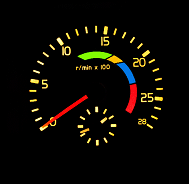
B
C
D
Correct Answer: B
Explanation: There are usually four coloured bands on the rev counter: green, amber, blue and red. The blue band will allow you to make the best use of engine braking. Try to keep in this band when going down a steep hill.
Explanation: There are usually four coloured bands on the rev counter: green, amber, blue and red. The blue band will allow you to make the best use of engine braking. Try to keep in this band when going down a steep hill.
77. You're applying for an LGV or PCV licence for the first time. What will your medical examination include?
Mark one answer
B
C
D
Correct Answer: D
Explanation: If you apply for a PCV or LGV licence, you must demonstrate that your eyesight is good enough to drive safely. DVLA (or DVA in Northern Ireland) can give you specific information about this. It's your responsibility to tell DVLA or DVA if your eyesight changes or you can't meet the requirements.
Explanation: If you apply for a PCV or LGV licence, you must demonstrate that your eyesight is good enough to drive safely. DVLA (or DVA in Northern Ireland) can give you specific information about this. It's your responsibility to tell DVLA or DVA if your eyesight changes or you can't meet the requirements.
78. Poor eating habits can increase your risk of long-term health problems. What may result from a poor diet?
Mark one answer
B
C
D
Correct Answer: C
Explanation: A poor diet can increase your risk of ill health. It may cause obesity, diabetes or heart disease, which can increase your risk of sudden incapacity at the wheel. There's a greater risk of developing a serious illness - and ultimately an early death. Smoking and a lack of exercise will increase the risks.
Explanation: A poor diet can increase your risk of ill health. It may cause obesity, diabetes or heart disease, which can increase your risk of sudden incapacity at the wheel. There's a greater risk of developing a serious illness - and ultimately an early death. Smoking and a lack of exercise will increase the risks.
79. You arrive at the scene of an incident. How should you deal with someone who is hysterical?
Mark one answer
B
C
D
Correct Answer: D
Explanation: A person who's hysterical may do things that you wouldn't expect. Try to keep the distressed person calm and safe until the emergency services arrive.
Explanation: A person who's hysterical may do things that you wouldn't expect. Try to keep the distressed person calm and safe until the emergency services arrive.
B
C
D
Correct Answer: C
Explanation: Various types of smart card are used in digital tachograph systems:
Explanation: Various types of smart card are used in digital tachograph systems:
- driver card, used by drivers
- company card, used by operators
- workshop card, available only to approved calibration centres
- control card, available only to Driver and Vehicle Standards Agency (DVSA) officials and the police, for carrying out enforcement.
81. You're at the scene of a traffic incident. What are the symptoms of someone suffering from shock?
Mark one answer
B
C
D
Correct Answer: C
Explanation: Prompt treatment can help to deal with shock. Warning signs to look for include rapid pulse, sweating, pale grey skin, and rapid shallow breathing. While waiting for help to arrive, keep the casualty warm and comfortable, and speak reassuringly to them.
Explanation: Prompt treatment can help to deal with shock. Warning signs to look for include rapid pulse, sweating, pale grey skin, and rapid shallow breathing. While waiting for help to arrive, keep the casualty warm and comfortable, and speak reassuringly to them.
Correct Answer: C
Explanation: When an analogue tachograph is installed and calibrated, an installation plaque is fixed near the tachograph. This shows the date of the most recent tachograph calibration. Under EU rules, this must take place every six years.
Explanation: When an analogue tachograph is installed and calibrated, an installation plaque is fixed near the tachograph. This shows the date of the most recent tachograph calibration. Under EU rules, this must take place every six years.
83. You're at the scene of a collision. People are injured. What should be done when the risk of further collisions has been dealt with?
Mark one answer
B
C
D
Correct Answer: C
Explanation: Make sure you or someone else has called the emergency services. Check the casualties and, if you feel able to give first aid, do so. Alternatively, ask any bystanders if they can help.
Explanation: Make sure you or someone else has called the emergency services. Check the casualties and, if you feel able to give first aid, do so. Alternatively, ask any bystanders if they can help.
84. After driving continuously for the maximum period under EU rules, a bus driver must take a break. What's the minimum duration of this break?
Mark one answer
B
C
D
Correct Answer: C
Explanation: After a driving for a period of no more than 4.5 hours, you must take a break of at least 45 minutes, which mustn't be interrupted. If you're carrying passengers, they'll probably also be grateful for a break. Taking breaks at the correct time will keep you and your passengers safe and comfortable.
Explanation: After a driving for a period of no more than 4.5 hours, you must take a break of at least 45 minutes, which mustn't be interrupted. If you're carrying passengers, they'll probably also be grateful for a break. Taking breaks at the correct time will keep you and your passengers safe and comfortable.
Correct Answer: A
Explanation: A smooth ride at all times isn't always easy to achieve. However, scanning ahead for hazards will help you avoid late braking and cornering too fast.
Explanation: A smooth ride at all times isn't always easy to achieve. However, scanning ahead for hazards will help you avoid late braking and cornering too fast.
86. You're driving a bus displaying this sign. When can you use its hazard warning lights?
Mark one answer
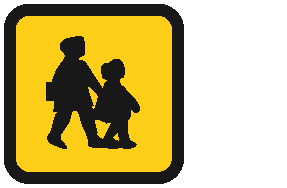
B
C
D
Correct Answer: B
Explanation: You may be driving in the rush hour, when traffic is heavy, so when you stop you're permitted to show your hazard warning lights. This will tell other road users that children are getting on and off the bus. Look out for passing traffic and make sure that all your passengers get on and off safely.
Explanation: You may be driving in the rush hour, when traffic is heavy, so when you stop you're permitted to show your hazard warning lights. This will tell other road users that children are getting on and off the bus. Look out for passing traffic and make sure that all your passengers get on and off safely.
87. Some coaches have a mirror on their nearside, angled down to show the front nearside wheel. When should this extra mirror be used?
Mark one answer
B
C
D
Correct Answer: D
Explanation: This mirror offers the most benefit when you're manoeuvring in confined spaces. It shows you where your nearside front wheel is in relation to the kerb or a bay marking line.
Explanation: This mirror offers the most benefit when you're manoeuvring in confined spaces. It shows you where your nearside front wheel is in relation to the kerb or a bay marking line.
B
C
D
Correct Answer: B
Explanation: Tyre checks should be made as a matter of routine. Inspect both the inside and outside walls, as well as the treads, for signs of wear, damage, bulges, separation and exposed cords.
Explanation: Tyre checks should be made as a matter of routine. Inspect both the inside and outside walls, as well as the treads, for signs of wear, damage, bulges, separation and exposed cords.
Correct Answer: A
Explanation: A full category D licence entitles you to drive all buses and coaches, including the articulated type. A full category D licence on its own doesn't cover you to drive buses or coaches drawing detachable trailers of more than 750 kg; for this you'll need a D+E licence.
Explanation: A full category D licence entitles you to drive all buses and coaches, including the articulated type. A full category D licence on its own doesn't cover you to drive buses or coaches drawing detachable trailers of more than 750 kg; for this you'll need a D+E licence.
90. Some buses have different-sized wheels on the front and rear. What do you need to be aware of when driving at high speeds on long journeys?
Mark one answer
B
C
D
Correct Answer: D
Explanation: Because small wheels need to rotate faster, their tyres are more likely to overheat on long journeys at speed. Make sure you check them when you take rest stops.
Explanation: Because small wheels need to rotate faster, their tyres are more likely to overheat on long journeys at speed. Make sure you check them when you take rest stops.
B
C
D
Correct Answer: D
Explanation: When passing other road users - especially motorcyclists and cyclists - in wet weather, the spray from your vehicle could affect their control. Leave plenty of room as you pass, and look in your left-hand mirror to check that they're still in control.
Explanation: When passing other road users - especially motorcyclists and cyclists - in wet weather, the spray from your vehicle could affect their control. Leave plenty of room as you pass, and look in your left-hand mirror to check that they're still in control.
Correct Answer: B
Explanation: A bus equipped with a speed limiter must also be fitted with a plate showing the speed setting. This must be fitted in an obvious position, where it can be clearly seen.
Explanation: A bus equipped with a speed limiter must also be fitted with a plate showing the speed setting. This must be fitted in an obvious position, where it can be clearly seen.
Correct Answer: B
Explanation: The way you drive matters. The safety and comfort of your passengers is your priority; if you have the correct attitude when you're driving, your passengers will be assured of a comfortable and pleasant journey. Good forward planning and anticipation will help you avoid having to turn or brake suddenly.
Explanation: The way you drive matters. The safety and comfort of your passengers is your priority; if you have the correct attitude when you're driving, your passengers will be assured of a comfortable and pleasant journey. Good forward planning and anticipation will help you avoid having to turn or brake suddenly.
94. You're driving a bus at night on a road without street lighting. Why could it be dangerous to overtake?
Mark one answer
B
C
D
Correct Answer: C
Explanation: On unlit roads, it's more difficult to see bends, junctions or dips ahead. This could prevent you from seeing oncoming traffic, pedestrians or cyclists. Unless the road is well lit or you're on a dual carriageway, ask yourself whether overtaking is absolutely necessary.
Explanation: On unlit roads, it's more difficult to see bends, junctions or dips ahead. This could prevent you from seeing oncoming traffic, pedestrians or cyclists. Unless the road is well lit or you're on a dual carriageway, ask yourself whether overtaking is absolutely necessary.
95. The bus you're driving is fitted with automatic transmission. When would you use kickdown?
Mark one answer
B
C
D
Correct Answer: C
Explanation: The kickdown facility on automatic transmission allows a lower gear to be engaged to allow faster acceleration (for example, when overtaking). This is achieved by firmly pressing the accelerator to the floor.
Explanation: The kickdown facility on automatic transmission allows a lower gear to be engaged to allow faster acceleration (for example, when overtaking). This is achieved by firmly pressing the accelerator to the floor.
96. Your bus is fitted with lifts or ramps for less mobile passengers. Who should operate this equipment?
Mark one answer
B
C
D
Correct Answer: C
Explanation: Make sure that you're fully trained in the safe use of lifts, ramps and securing devices. If you drive a vehicle fitted with this equipment, never let untrained people operate it.
Explanation: Make sure that you're fully trained in the safe use of lifts, ramps and securing devices. If you drive a vehicle fitted with this equipment, never let untrained people operate it.
Correct Answer: A
Explanation: Kneeling buses are equipped with air or hydraulic systems that allow the vehicle body to be lowered. This improves access for disabled and elderly passengers. Remember to return the mechanism to its travelling position before moving off.
Explanation: Kneeling buses are equipped with air or hydraulic systems that allow the vehicle body to be lowered. This improves access for disabled and elderly passengers. Remember to return the mechanism to its travelling position before moving off.
98. You're driving a six-wheeled double-deck bus. What do you need to know about punctures on the rear tyres?
Mark one answer
B
C
D
Correct Answer: B
Explanation: The handling of a six-wheeled bus or coach is not much different from that of a two-axle vehicle, except that punctures can be more difficult to detect.
Explanation: The handling of a six-wheeled bus or coach is not much different from that of a two-axle vehicle, except that punctures can be more difficult to detect.
B
C
D
Correct Answer: A
Explanation: Use your nearside mirror when you've overtaken another vehicle. This is particularly important on dual carriageways or motorways, where it can take some distance to overtake safely. Look carefully to make sure you're far enough ahead and can safely return to the left lane.
Explanation: Use your nearside mirror when you've overtaken another vehicle. This is particularly important on dual carriageways or motorways, where it can take some distance to overtake safely. Look carefully to make sure you're far enough ahead and can safely return to the left lane.
100. Which authority has the power to impose conditions on a passenger-carrying vehicle (PCV) operator's licence?
Mark one answer
B
C
D
Correct Answer: D
Explanation: Traffic commissioners are responsible for administering the regulations governing a PCV operator's licence. They can take disciplinary action against an operator who falls foul of the legal requirements.
Explanation: Traffic commissioners are responsible for administering the regulations governing a PCV operator's licence. They can take disciplinary action against an operator who falls foul of the legal requirements.


